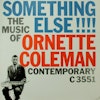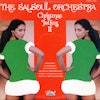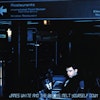Throughout the Doors’ “The WASP (Texas Radio and the Big Beat),” a growling Jim Morrison barks a song of “a back beat narrow and hard to master,” “heavenly in its brilliance,” “mean and rueful of the Western dream,” and “soft driven, slow and mad, like some new language.”
Out here on the perimeter, there are no stars
Out here we is stoned. Immaculate.
Morrison wasn’t talking about the music of Fort Worth, Texas’s Ornette Coleman. Not the innovative, harmolodic, alto saxophone–playing composer of the future, free-form The Shape of Jazz to Come. Not the blues-honking lounge musician who, after he moved to California, muscled his first album as a leader, Something Else!!!!, into an unsuspecting 1958.
Then again, considering Morrison’s lyrical qualifiers, he very well could have been talking about the immaculate who would remake jazz’s avant-garde in his image.
While cream-colored plastic sax–playing Ornette Coleman would have to wait another year to create an entirely new language on the aforementioned The Shape of Jazz to Come, there is much stoned immaculate music, heavenly in its brilliance, slow, mad, and hard to master (for critics, then, harder to comprehend) on Something Else!!!! If anything, Coleman was on his way, here, to the building blocks of this fresh dialogue—a stark, blues-based communique; that is, if America’s Black rural tradition had been surrounded by the rings of Saturn.
Listen to “The Sphinx,” an un-pure blues in its slowest measures, an elegant bop portrait as its piano trills and thrills, the song soars and swerves to the heavens and other planetary hemispheres when Coleman steps in. Every time.
Produced by Lester Koenig, the founder of Contemporary Records, and engineered by Roy DuNann, the first true thing about Something Else!!!! is that this debut is warmer sounding than Coleman’s most inventive recordings to follow (credit DuNann, who brought a similar luxuriating heat, early on, to albums from Shelly Manne and Sonny Rollins). Credit the blues too, and Coleman’s lone stricture, that of a familiar hard bop sound’s tempo. Then, there is the fact that Something Else!!!! is the first and last time we hear the convention of a piano on an Ornette Coleman album, as after this, the genius saxophonist-composer will move toward a spare and more fluid sound—a freer sound. Listen to the unbridled soloing path Coleman races along, quickly, on “The Disguise.” Now, imagine it unbound by a piano’s block and tinkle.
Eventual Thad Jones–Mel Lewis band pianist Walter Norris, drummer Billy Higgins, double bassist Don Payne, and young cornetist Don Cherry joined Coleman for what was a then-standard bebop quintet’s setting. Their goal, if there was a hard intentional goal, was to turn the blues—the root of all American music—on its head courtesy of the jazz idiom. And with that, create a noise with a rhythm that never quit. For no matter how off or outer-bounds Something Else!!!! gets, it swings and grooves. For that, credit Higgins, the Los Angeles–based drummer who, before he threw in with Coleman and Cherry and moved the needle off the black and into the red for free jazz, was a rough rhythmic R&B sticks man for cats such as Jimmy Witherspoon, Bo Diddley, and Amos Milburn.
The double stammering, D-flat blues burst of pitchy reeds and brass that is “Invisible” opens Something Else!!!!, with Coleman’s lurking sax solo spitting and punching its way through Higgins and Norris’s heavy rhythm like a tiger on Vaseline caught up in Saran Wrap. A sprightly, cymbal ride and a pixie-ish piano opens “Jayne,” Coleman’s uneasily squeaky love song to his wife, Jayne Cortez. Sedulous and assertive, Coleman’s wonk is never tentative, even if, at times, the rest of the ensemble’s solos are strict or more reserved than their plastic sax–toting leader. In that, only Cherry and Higgins seem to own the breezy blues freedom that Coleman has allowed/demanded of the young cornetist. Following beside Coleman, bop-like, on every track throughout Something Else!!!!, when Cherry breaks out, the winds of Change to Come lift his solos through an idiosyncratic, tongue-spoken spirit that approximates abstract expressionism.
In fact, if we think of Coleman, Cherry, and the free onslaught that is Something Else!!!!, it is best viewed in relation to that post–World War II art form and its reliance on subconscious, spontaneous craft. With that, while Cherry is the darkly expansive Robert Motherwell, the second wave of action painters to pick up the gauntlet of abstract expressionism, Ornette Coleman is its Jackson Pollock—a splatter king of raw emotion, mathematical thought, and a high plains drifter behind a uniquely American dream landscape.


